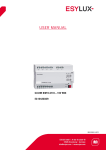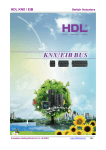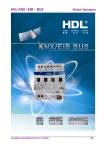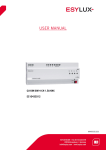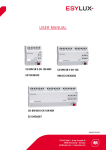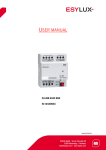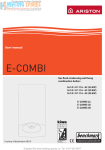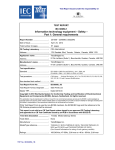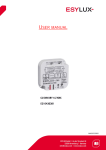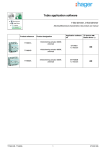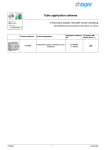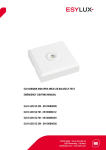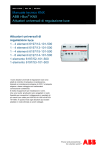Download USER MANUAL
Transcript
USER MANUAL
CU-DIN R 4-CH 16 A KNX
CU-DIN R 8-CH 16 A KNX
EC10430282
EC10430299
CU-DIN R 12-CH 16 A KNX
EC10430305
MA00629501
USER MANUAL
Table of contents
1
Description ................................................................................................4
2
Safety instructions ......................................................................................4
3
Product function ........................................................................................5
4
Hardware...................................................................................................6
4.1
4.2
4.3
4.4
5
Software ..................................................................................................12
5.1
5.2
5.3
5.4
5.5
5.6
6
Technical data ................................................................................ 6
Dimension drawings ........................................................................ 9
Wiring diagram ............................................................................. 10
Maintenance and cautions.............................................................. 11
Program functions diagram ............................................................. 13
Defining object/association/group address ........................................ 14
Function parameter “General” ........................................................ 15
Function parameter “Channel A”..................................................... 16
Channel mode “Switch actuator” .................................................... 17
5.5.1 Channel function ............................................................... 20
5.5.2 Channel function parameters .............................................. 20
5.5.3 Channel function “time”..................................................... 22
5.5.3.2 Channel function “Time-staircase lighting” ........................... 25
5.5.4 Channel function “Scene” .................................................. 28
5.5.5 Channel function “Threshold” ............................................. 30
5.5.6 Channel function “Blinds” .................................................. 35
5.5.7 Channel function “Logic” ................................................... 37
Channel “Heating actuator” ............................................................ 41
Communication objects description ...........................................................46
6.1
6.2
Objects “General” and “Output A” .................................................. 46
All objects with channel A .............................................................. 47
6.2.1 Objects “Response” ........................................................... 47
6.2.2 Objects “R/W statistics for time” ......................................... 47
6.2.3 Objects “Alarm for ON timeout” .......................................... 48
6.2.4 Objects “R/W statistics counter”.......................................... 48
6.2.5 Objects “Alarm for ON counter out” ..................................... 48
6.2.6 Objects “Flashing” ............................................................ 48
6.2.7 Objects “Staircase light” .................................................... 49
6.2.8 Objects “Change staircase lighting time” .............................. 49
6.2.9 Objects “Alarm for staircase lighting” .................................. 49
6.2.10 Objects “Scene” ................................................................ 50
CU-DIN R 4-CH 16 A KNX
CU-DIN R 8-CH 16 A KNX
CU-DIN R 12-CH 16 A KNX
2 / 54
USER MANUAL
6.2.11
6.2.12
6.2.13
6.2.14
6.2.15
Objects
Objects
Objects
Objects
Objects
“Threshold”........................................................... 50
“Blinds” ............................................................... 51
“Logic” ................................................................. 52
“Heating” ............................................................. 52
“Forced position” ................................................... 53
7
Product disposal ......................................................................................53
8
ESYLUX manufacturer´s guarantee .............................................................53
CU-DIN R 4-CH 16 A KNX
CU-DIN R 8-CH 16 A KNX
CU-DIN R 12-CH 16 A KNX
3 / 54
USER MANUAL
1
Description
The ESYLUX KNX/EIB series-switching actuator output modules are developed by
ESYLUX. KNX/EIB BUS is used to communicate with other KNX devices. The
database needs to be downloaded to the switch actuator by using ETS
3.0F/ETS4/ETS5; the document describes how to use the products. Our
products are manufactured according to EMC, electrical safety and
environmental standards.
The switch actuators are used to control switched loads, such as:
Lighting
Motor
Blinds
Heating
Other equipment
Note: Use this product only as intended (as described in the user instructions).
Do not make any changes or alterations as this will render any warrantees null
and void. You should check the device for damage immediately after unpacking
it. If there is any damage, you should not install the device under any
circumstances.
If you suspect that safe operation of the device cannot be guaranteed, you
should turn the device off immediately and make sure that it cannot be operated
unintentionally.
2
Safety instructions
Work on the 230 V power system must be carried out by authorized personnel
only, with due regard to the applicable installation regulations.
Switch off the power supply before installing the system.
The 21–30 V KNX bus voltage cannot be used as 24 V operating or auxiliary
voltage.
Max. relay output: 16 A
CU-DIN R 4-CH 16 A KNX
CU-DIN R 8-CH 16 A KNX
CU-DIN R 12-CH 16 A KNX
4 / 54
USER MANUAL
3
Product function
The switch actuators can be used for 4, 8 and 12 channels independent AC/DC
loads. The outputs for MAX 16 A can be switched ON or OFF on every output
channel and can be switched manually too. The CU-DIN R 4-CH does not
require an additional power supply. The CU-DIN R 8-CH and CU-DIN R 12-CH
require an additional 24 V DC power supply if all of the channels are frequently
operated at the same time, but normal operation is also possible if there is no
additional power supply. The following functions can be set individually for each
output channel:
Channel state response
Channel state after bus voltage
failure and recovery
Time function
Flashing
Staircase light
Delay
Scene
Scene number: 1-64
Threshold
Two threshold values
Curtain
Top/left<->bottom/right
Logic
AND/OR/XOR/GATE
Heating control
PWM
CU-DIN R 4-CH 16 A KNX
CU-DIN R 8-CH 16 A KNX
CU-DIN R 12-CH 16 A KNX
5 / 54
USER MANUAL
4
Hardware
The technical properties of the ESYLUX KNX/EIB switch actuators are described
in the following sections.
4.1 Technical data
Power supply
Operating voltage (supplied by
the bus)
Current consumption EIB/KNX
(operation)
Current consumption EIB/KNX
(standby)
Power consumption EIB/KNX
(operation)
Power consumption EIB/KNX
(standby)
Output nominal values
Type of
device M/R
Number of
contacts
Rated
current
Power loss
per device at
max. load
Rated
voltage
< 15 mA
< 5 mA
< 450 mW
< 150 mW
R 4-CH
R 8-CH
R 12-CH
4
8
12
16A
16A
16A
2.7 W
5.4 W
8W
230V ~
230V ~
230V ~
Output switching currents
AC operation (cos1 = 0.8)
Fluorescent lighting load
Minimum switching capability
CU-DIN R 4-CH 16 A KNX
CU-DIN R 8-CH 16 A KNX
CU-DIN R 12-CH 16 A KNX
21–30 V
12 A / 230 V
16 A / 230V (300 μF)
0.1 mA / 1 V
6 / 54
USER MANUAL
DC current switching capability (ohmic
load) output life expectancy
Mechanical life
Electrical life (230 V/cos phi =
0.8)
Output switching delay without additional
DC power
Max. delay time of relay per
position change (charge time of
the capacity)
16 A / 12 V DC
> 1,000,000
> 100,000
R 4-CH
CH
400 ms
ms
R 8-CH
R 12-
400 ms
400
Note: Note: The device has a voltage (capacity of relay driver) detect function.
It remains active and stores the state of the relays in the memory of the device
when the voltage goes down to stop level. This function is thereby able to
successfully prevent the relay from becoming inactive. When the voltage
(capacity of relay driver) goes back up to active level, the state of the relays are
recovered from the memory, thereby enabling the relays to become active again.
This function is very useful when there is no additional DC power application in
the system, and the delay time is approx. 0.4 s on switch state change when the
charge of the capacity is not enough.
Output switching delay with additional DC
power
Max. delay time of relay per position
change (charge time of the capacity)
R 8-CH
100 ms
R 12-CH
100 ms
Note: in some applications, the relay needs to be switched ON/OFF frequently,
and does not allow too much delay time. In such cases it can be connected to
an additional 24 V power supply. The max. current required are 24 mA when
the relay is actived, and required the standby current is 4 mA. The delay time is
approx. 400 ms on switch state change when the applied power is not sufficient.
Connections
EIB/KNX
Load circuits
CU-DIN R 4-CH 16 A KNX
CU-DIN R 8-CH 16 A KNX
CU-DIN R 12-CH 16 A KNX
Bus Connection Terminal
0.8 mm Ø, single core
Screw terminal with slotted head
0.2–4 mm² multi-core
0.4–6 mm² single-core
7 / 54
USER MANUAL
12 mm
Max. 0.8 Nm
Cable shoe
Tightening torque
Operation and display
Red LED and EIB/KNX push
button all in one
Contact position indication
Temperature range
Operation
Storage
Transport
Environmental conditions
Humidity
Appearance design
Modular
Type (M/R)
Dimensions
Width W (unit
mm)
Mounting width
(1SU=18 mm)
Mounting depth
(unit mm)
Weight (unit kg)
Installation
Mounting
position
Material and
colour
For assignment of the physical
address
Relay lever
0°C – +45°C
-40°C – +55°C
-25°C – +70°C
Max. 93%, non-condensing
DIN-Rail modular installation
R 4-CH
R 8-CH
R 12-CH
90 x W x 65
72
144
216
4SU
8SU
12SU
65
65
65
0.26
0.49
Use 35 mm mounting rail
Electric switch box
0.72
Plastic, white
CE Mark in accordance with
2004/1008/EC
EMC
Standard
2006/95/EC
LVD
Standard
2011/65/EU
RoHS
CU-DIN R 4-CH 16 A KNX
CU-DIN R 8-CH 16 A KNX
CU-DIN R 12-CH 16 A KNX
8 / 54
USER MANUAL
Note: All loads, at 230 V AC
Motors
Lamps
Incandescent lamp load
Low-volt halogen lamps
Inductive transformer
Electronic transformer
Halogen lamp 230V
Mercury-vapour lamp
Uncompensated luminaire
Parallel compensated
Fluorescent lamp T5/T8
Uncompensated luminaire
Parallel compensated
DUO lamp
Dulux lamp
Uncompensated luminaire
Parallel compensated
Switching performance (contact)
Max. peak inrush current IP
Max. peak inrush current IP
Max. peak inrush current IP
Max. peak inrush current IP
3 KW
3500 W
1800 W
2000 W
3500 W
2800 W
2800 W
3500 W
2000 W
2000 W
1500 W
1500 W
(120 μs)
(240 μs)
(480 μs)
(1000 μs)
600
480
300
170
A
A
A
A
4.2 Dimension drawings
4-CH
72 mm
8-CH
144 mm
CU-DIN R 4-CH 16 A KNX
CU-DIN R 8-CH 16 A KNX
CU-DIN R 12-CH 16 A KNX
12-CH
216 mm
9 / 54
USER MANUAL
4.3 Wiring diagram
Note: On the input side, the device is to be protected against short circuits with
a 16 A circuit breaker.
1. Label area
2. Programming button&programming
LED
3. KNX/EIB bus connector
4. Terminal for load connection
5. Contact position indication and
manual operation
6 Additional power 24 V (max. 24 mA in
operation, min. 4 mA in standby).
CU-DIN R 4-CH 16A KNX
CU-DIN R 8-CH 16A KNX
CU-DIN R 4-CH 16 A KNX
CU-DIN R 8-CH 16 A KNX
CU-DIN R 12-CH 16 A KNX
10 / 54
USER MANUAL
CU-DIN R 12-CH 16A KNX
Note:
a) Dimensions of the space to be provided for each switch
b) Dimensions and position of the means for supporting and fixing the switch
within this space
c) Minimum clearance between the various parts of the switch and the
surrounding parts where fitted
d) Minimum dimensions of ventilation opening, if needed, and their correct
arrangement.
e) Protective devices (e.g. fuses, automatic protective devices, etc.) to be
connected to the load to avoid overloading
4.4 Maintenance and cautions
Please read this user manual carefully before operation.
Do not operate close to interfering devices.
The site should be ventilated with good cooling environment.
Take care to damp-proof, quake-proof and dust-proof.
Avoid rain, other liquids or caustic gas.
Please contact professional maintenance staff or ESYLUX service centre for
repair or fix.
Remove the dust regularly and do not wipe the unit with volatile liquids like
alcohol, gasoline, etc.
If damaged by damp or liquid, turn off immediately.
CU-DIN R 4-CH 16 A KNX
CU-DIN R 8-CH 16 A KNX
CU-DIN R 12-CH 16 A KNX
11 / 54
USER MANUAL
5
Regularly check the wiring and other related circuits and cables, and
replace faulty circuitry when necessary.
For security, each wiring should be connected to an MCB or fuse
Installation location should be well-ventilated; pay attention to moisture,
shock and dust.
Software
The ESYLUX KNX/EIB switch actuator database can be used with ETS3.0F, ETS4
and ETS5 for the programmation. The device types are CU-DIN R 4-CH, CU-DIN
R 8-CH and CU-DIN R 12-CH and the database names are:
EC10430282_ CU-DIN R 4-CH 16 A KNX.VD5
EC10430299_ CU-DIN R 8-CH 16 A KNX.VD5
EC10430305_ CU-DIN R 12-CH 16 A KNX.VD5
All parameters and interfaces are described in the following paragraph.
Each channel output of the switch actuators is independent and equal. So,
understanding of only one channel output is sufficient. The following paragraph
will describe the first channel output in detail.
CU-DIN R 4-CH 16 A KNX
CU-DIN R 8-CH 16 A KNX
CU-DIN R 12-CH 16 A KNX
12 / 54
USER MANUAL
5.1 Program functions diagram
CU-DIN R 4-CH 16 A KNX
CU-DIN R 8-CH 16 A KNX
CU-DIN R 12-CH 16 A KNX
13 / 54
USER MANUAL
5.2 Defining object/association/group address
The following table shows the max. number of communication objects,
associations and group addresses. The object is assigned to certain functions of
the channel output pages. If the functions are activated, the corresponding
objects will be available. One or more group addresses can be assigned to an
object. The association will connect group addresses to the object.
Type
VD5
Max. number of
communication
objects
90
Max. number of
associations
Max. number of
group addresses
CU-DIN R 4-CH
254
254
16 A
CU-DIN R 8-CH
170
254
254
16 A
CU-DIN R 12-CH 250
254
254
16 A
Table 1: Overview of the max. number of objects, max. number of associations
and max. number of group addresses.
Note:
ETS3.0F-> Import “VD3” to “VD5”.
ETS4-> Import “.KNXPROD”.
ETS5
CU-DIN R 4-CH 16 A KNX
CU-DIN R 8-CH 16 A KNX
CU-DIN R 12-CH 16 A KNX
14 / 54
USER MANUAL
5.3 Function parameter “General”
Fig 1: “General” parameters window
In the General parameters window, two parameters can be set:“Switching delay
after recovery ” and “Cycle send general telegram”.
Operation delay after recovery (2–200 s)
Can be used for a delay time of 2–200 s after the power is available again. The
default value is 2 seconds. The min. value is 2 seconds and the max. value is
200 seconds.
Options:
2-200 s
After voltage recovery and the adjusted delay-time (2–200 s) is counted down
the switch is ready for use. This function is selected by the user.
Sending cycle of object “In operation”(1–65,535 s, 0 - invalid)
The range of the parameter is 0 to 65,535 s. A zero parameter disables the
function, other parameters enable this function
Options:
1–65,535 s
CU-DIN R 4-CH 16 A KNX
CU-DIN R 8-CH 16 A KNX
CU-DIN R 12-CH 16 A KNX
15 / 54
USER MANUAL
When the parameter is set to non-zero, the device will send telegram data
cyclically on timeout. Send the value alternately between 0 and 1.
5.4 Function parameter “Channel A”
Fig 2: “Channel A” window
In the “Channel A” parameter window, some common functions can be set up.
After selecting a function and downloading the database to the device, the
device will work in accordance with the selected function.
Note: take channel A as an example; other channels are the same as A.
Channel A work mode:
The functions of Channel A work mode output can be selected with three
parameters.
Options:
Switch actuator
Heating actuator
Inactivated
If “Inactivated” is selected, channel A function will be invalid, but it will work in
the other two modes.
CU-DIN R 4-CH 16 A KNX
CU-DIN R 8-CH 16 A KNX
CU-DIN R 12-CH 16 A KNX
16 / 54
USER MANUAL
5.5 Channel mode “Switch actuator”
Fig 3: Switch actuator window.
More functions can be set up in this mode; the following section provides a
detailed description of the Switch Actuator mode.
Normally connected type
This parameter is the choice of the type of access load
Options:
Normally closed
Normally opened
Normally closed: Contact in de-energised state is closed.
Normally Opened: Contact in de-energised state is open.
Response of switch state ON/OFF
This parameter provides a choice of the switching state feedback.
Options:
No response
Always respond
Only after change
No response: No response of the switch state.
CU-DIN R 4-CH 16 A KNX
CU-DIN R 8-CH 16 A KNX
CU-DIN R 12-CH 16 A KNX
17 / 54
USER MANUAL
Always respond: Always receive a response of the switch state when a channel
telegram data is received.
Only after change: Only receive a response of the switch state when channel
stateis changed.
Save statistic for ON switching “time(hour-2bytes)”
Statistics for channel ON time, useful for management and monitoring.
Options:
Disable
Enable
Disable: Disable statistics.
Enable: Enable statistics only for the ON time.
Alarm for time out
Options:
No
Yes
No: No alarm when time out.
Yes: Alarm.
Alarm when time out (1–65,535 h)
This parameter sets the ON time alarm overflow time.
Options:
1–65,535 h
Alarm telegram interval when time out (1–255 s)
This parameter sets the ON time overflow alarm interval.
Options:
1–255 s
Alarm telegram number (1–255, 0 – unlimited)
This parameter sets the number of telegram repetitions for the alarm.
Options:
0–unlimited
1–255
Save statistic for ON switching “counter (4bytes)”
Statistic channel switch ON counter
Options:
Disable
Enable
Disable: Disable Statistic ON counter
Enable: Enable Statistic ON counter
Alarm for counter out
Options:
No
Yes
No: No alarm
Yes: Alarm
CU-DIN R 4-CH 16 A KNX
CU-DIN R 8-CH 16 A KNX
CU-DIN R 12-CH 16 A KNX
18 / 54
USER MANUAL
Alarm when counter out (10–10,000,000)
This parameter sets the value for the counter (out) alarm.
Options:
10–10,000,000
Alarm telegram interval when counter out (1–255 s)
This parameter sets the ON-counter overflow interval between alarm telegrams.
Options:
1–255 s
Alarm telegram number (1–255, 0 – unlimited)
This parameter sets the ON counter overflow alarm number.
Options:
0–unlimited
1–255
The switch state on bus voltage failure
When the bus voltage fails, this function will give a reaction. Three choices will
be available as follows:
Options:
Unchange
ON
OFF
Unchange: The channels switch position will be unchanged after bus voltage
failure.
ON:
The channel will switch ON after bus voltage failure
OFF: The channel will switch OFF after bus voltage failure
The Operation of switch after bus voltage recovery
When power is on during bus voltage recovery, this function will be executed.
Four choices will be available as follows:
Options:
Unchange
Recovery
ON
OFF
Unchange: The channel switch position will be unchanged after bus voltage
recovery.
Recovery: After bus voltage recovery, the channel switch position will revert to its
state at the previous power-down.
ON: The channel position will switch ON after bus voltage recovery.
OFF: The channel position will switch OFF after bus voltage recovery.
Show the function page
If this parameter is activated, the channel function page will be shown. The
function page offers Time, Scene, Threshold, Blinds and Logic. For details see
the following sections.
CU-DIN R 4-CH 16 A KNX
CU-DIN R 8-CH 16 A KNX
CU-DIN R 12-CH 16 A KNX
19 / 54
USER MANUAL
5.5.1
Channel function
The following will describe the parameters for setup of the channel.
5.5.2
Channel function parameters
Fig 4: Channel function window
In the factory-defaults each channel function is disabled. When enabled, the
channel function will be available.
Enable function “time”
If set to Enable, the time function will be enabled.
Options:
Disable
Enable
Disable: The time function is disabled.
Enable: The time function is enabled.
CU-DIN R 4-CH 16 A KNX
CU-DIN R 8-CH 16 A KNX
CU-DIN R 12-CH 16 A KNX
20 / 54
USER MANUAL
Enable function "scene"
If set to Enable, the scene function will be enabled.
Options:
Disable
Enable
Disable: The scene function is disabled.
Enable: The scene function is enabled.
Enable function "threshold"
If set to Enable, the threshold function will be enabled.
Options:
Disable
Enable
Disable: The threshold function is disabled.
Enable: The threshold function is enabled.
Enable function "blinds"
If set to Enable, the blinds function will be enabled.
Options:
Disable
Enable
Disable: The blinds function is disabled.
Enable: The blinds function is enabled.
Enable function "logic"
If set to Enable, the logic function will be enabled.
Options:
Disable
Enable
Disable: The Logic function is disabled.
Enable: The Logic function is disabled.
CU-DIN R 4-CH 16 A KNX
CU-DIN R 8-CH 16 A KNX
CU-DIN R 12-CH 16 A KNX
21 / 54
USER MANUAL
5.5.3
Channel function “time”
Fig 5: Time function window
The time function includes three work modes as follows:
Options:
Flashing
Staircase lighting
ON/OFF delay
CU-DIN R 4-CH 16 A KNX
CU-DIN R 8-CH 16 A KNX
CU-DIN R 12-CH 16 A KNX
22 / 54
USER MANUAL
5.5.3.1
CHANNEL FUNCTION “TIME-FLASHING”
Fig 6: Time-flashing function window
Channel will switch between ON and OFF in this mode.
Conditions of flash start/stop
There are three control modes for this function.
Options:
Start with ON, stop with OFF
Start with OFF, stop with ON
Always flash, start with ON/OFF
Start with ON, stop with OFF: Start flashing with ON and stop flashing with OFF.
Start with OFF, stop with ON: Start flashing with OFF and stop flashing with ON.
Always flash, start with ON/OFF: Start flashing with ON or OFF.
Time for on: (0–255 min)
Duration in minutes in the ON state.
Time for on: (0–59 sec)
Duration in seconds in the ON state.
CU-DIN R 4-CH 16 A KNX
CU-DIN R 8-CH 16 A KNX
CU-DIN R 12-CH 16 A KNX
23 / 54
USER MANUAL
Time for off: (0–255 min)
Duration in minutes in the OFF state.
Time for off: (0–59 sec)
Duration in seconds in the OFF state
Flashing cycles (1–100, 0 – Unlimited)
The number of flashing cycles, range between 0 and 100. 0 is unlimited.
Position after flashing stops
There are three options for the switch position after the flashing is stopped by
the overflow counter.
Options:
Unchange
ON
OFF
Unchange: The switch state position is set to Unchange, after the flashing is
stopped by the overflow counter.
ON: The switch state position is set to ON, after the flashing is stopped by the
overflow counter.
OFF: The switch state position is set to OFF, after the flashing is stopped by the
overflow counter.
CU-DIN R 4-CH 16 A KNX
CU-DIN R 8-CH 16 A KNX
CU-DIN R 12-CH 16 A KNX
24 / 54
USER MANUAL
5.5.3.2 Channel function “Time-staircase lighting”
Fig 7: Time-staircase lighting function window
For the staircase application.
Control staircase lighting
Control staircase lighting with three modes.
Options:
Start with ‘1’, stop with ‘0’
Start with ‘1’, invalid with ‘0’;
Start with ‘1’/‘0’, can't stop
Start with ‘1’, stop with ‘0’: When the received telegram value is ‘1’, the staircase
light is switched ON. When the received telegram value is ‘0’ or time out, the
staircase light is switched off.
Start with ‘1’, invalid with ‘0’: When the received telegram value is ‘1’, the
staircase light is switched ON. Invalid when the telegram value is ‘0’.
Start with ‘1’/‘0’, can't stop: When received telegram value is ‘1’ or ’0’, the
staircase light is switched ON.
CU-DIN R 4-CH 16 A KNX
CU-DIN R 8-CH 16 A KNX
CU-DIN R 12-CH 16 A KNX
25 / 54
USER MANUAL
Change staircase lighting time via bus
Options:
NO
YES
NO: Can’t change staircase lighting delay off time via bus, it can only be set by
ETS.
YES: Allow user to change staircase lighting delay off time via bus.
Alarm staircase lighting to bus
Options:
NO
YES
NO: No alarm.
YES: Alarm staircase light.
Time for off: (0–255 min)
Duration in minutes of the staircase lighting delay off time.
Time for off: (0–59 sec)
Duration in seconds of the staircase lighting delay off time.
Warning staircase lighting (ON->OFF->ON)
Options:
NO
YES
NO: Do not allow alarm.
YES: Allow alarm.
Warning before the end of time (3–255 sec)
Options:
2–255 seconds
Note: If the time of the timeout is the same as the staircase light time, the
warning function is invalid.
Duration time for warning (1–200 sec)
Options:
1–200 seconds
Note: If the value of the timeout is the same as the value of the staircase light
time, the warning function is invalid.
CU-DIN R 4-CH 16 A KNX
CU-DIN R 8-CH 16 A KNX
CU-DIN R 12-CH 16 A KNX
26 / 54
USER MANUAL
5.5.3.3
CHANNEL FUNCTION “TIME-ON/OFF DELAY”
Fig 8: Time-ON/OFF delay function window
This function is including switch ON delay, switch OFF delay, protect ON delay
and protect OFF delay. Some special devices are used in a protective operation
mode for ON or OFF.
Delay for switching ON: (0–255 min)
Duration in minutes of the ON delay
Delay for switching ON: (0–59 sec)
Duration in seconds of the ON delay.
Delay for switching OFF: (0–255 min)
Duration in minutes of the OFF delay.
Delay for switching OFF: (0–59 sec)
Duration in seconds of the OFF delay.
CU-DIN R 4-CH 16 A KNX
CU-DIN R 8-CH 16 A KNX
CU-DIN R 12-CH 16 A KNX
27 / 54
USER MANUAL
Delay for protection ON: (0–255 min)
Duration in minutes of the protected ON delay.
Delay for protection ON: (0–59 sec)
Duration in seconds of the protected ON delay.
Delay for protection OFF: (0–255 min)
Duration in minutes of the protected OFF delay.
Delay for protection OFF: (0–59 sec)
Duration in seconds of the protected OFF delay.
Note:
1-Protection ON delay
If the light is turned off and then turned on again immediately, the protection
ON delay time will be valid/active.
2-Protection OFF delay
If the light is turned on and then turned off again immediately, the protection
OFF delay time will be valid/active.
5.5.4
Channel function “Scene”
10 scenes per channel can be stored in the device.
The number of scenes can be selected between 1 and 64.
Channel B, C and on are the same as channel A.
CU-DIN R 4-CH 16 A KNX
CU-DIN R 8-CH 16 A KNX
CU-DIN R 12-CH 16 A KNX
28 / 54
USER MANUAL
Fig 9: Scene function window
10 scenes can be configured for each channel. Each scene can be set to ON or
OFF.
The scene will be activated by receiving a telegram value from the bus. The
value of the telegram (bit 0–6) is equal to a scene number. The seventh bit of
the telegram must be 0 to start the scene.
The scene is stored by receiving a telegram value from the bus. The value of the
telegram (bit 0–6) is equal to a scene number. The scene state is the current
switch state. The bit seven value of the telegram must be 1 to store the scene.
Output is assigned to scene 1–64 or not allocated
Options:
Not allocated
Scene No. 01
Scene No. 02
………………
Scene No. 64
The scene number is between 1 and 64, the value is between 0 and 63 or not
allocated.
CU-DIN R 4-CH 16 A KNX
CU-DIN R 8-CH 16 A KNX
CU-DIN R 12-CH 16 A KNX
29 / 54
USER MANUAL
Output ON/OFF:
Channel switch ON or OFF
Options:
ON
OFF
ON: Channel is switched ON.
OFF: Channel is switched OFF.
5.5.5
Channel function “Threshold”
5.5.5.1
CHANNEL FUNCTION “1 BYTE THRESHOLD”
There are two threshold values: the upper threshold and lower threshold. They
can be set between 0 and 255.
The upper and lower threshold values and the state of
ON and OFF can be set by using ETS software.
For example: ETS set A=ON, B=Unchanged, C=OFF.
CU-DIN R 4-CH 16 A KNX
CU-DIN R 8-CH 16 A KNX
CU-DIN R 12-CH 16 A KNX
30 / 54
USER MANUAL
Fig 10: 1 byte threshold type function window
There are two threshold values: threshold 1 and threshold 2. The threshold 1
and threshold 2 can be set between 0 and 255. The switch state can change
according to the input threshold value. It has three ways to compare with the
value of threshold.
Enable changes to threshold 1 over bus:
Options:
YES
NO
NO: Do not allow changes to threshold 1 via bus.
YES: Allow changes to threshold 1 via bus.
Enable changes to threshold 2 over bus:
Options:
YES
NO
NO: Do not allow changes to threshold 2 via bus.
YES: Allow changes to threshold 2 via bus.
Threshold 1 value is 0–255
Set threshold 1 value between 0 and 255. Default is 80
Options:
0–255
CU-DIN R 4-CH 16 A KNX
CU-DIN R 8-CH 16 A KNX
CU-DIN R 12-CH 16 A KNX
31 / 54
USER MANUAL
Threshold 2 value is 0–255
Set threshold 2 value between 0 and 255. Default is 180.
Options:
0–255
“Threshold input (0–255)” after bus voltage recovery
After a bus voltage recovery, the threshold value is set to the set value.
Options:
0–255
{Input object value<lower threshold}
If the value of the receiving telegram from the bus is lower than the minimum
threshold value, the switch will be activated according to the below options (ON
or OFF or no action)
Options:
Unchange
ON
OFF
Unchange: The channel switch position does not change.
ON:
The channel switch position is set to ON.
OFF: The channel switch position is set to OFF.
{Lower threshold<=Object value<=Upper threshold}
If the value of the receiving telegram from the bus is between the lower
threshold and upper threshold, the switch will be activated according to the
below options (ON or OFF or no action)
Options:
Unchange
ON
OFF
Unchange: The channel switch position is not changed.
ON: The channel switch position is set to ON.
OFF: The channel switch position is set to OFF
{Input object value>upper threshold}
If the value of the receiving telegram from the bus is more than the upper
threshold value, the switch will be activated according to the below options (ON
or OFF or no action)
Options:
Unchange
ON
OFF
Unchange: The channel switch position is not changed.
ON: The channel switch position is set to ON.
OFF: The channel switch position is set to OFF
CU-DIN R 4-CH 16 A KNX
CU-DIN R 8-CH 16 A KNX
CU-DIN R 12-CH 16 A KNX
32 / 54
USER MANUAL
5.5.5.2
CHANNEL FUNCTION “2 BYTES THRESHOLD”
Fig 11: 2 byte threshold type function window
The 2 bytes threshold function is the same as the 1 byte threshold function.
Enable changes to threshold 1 over bus:
Options:
YES
NO
NO: Do not allow changes to threshold 1 via bus.
YES: Allow changes to threshold 1 via bus.
Enable changes to threshold 2 over bus:
Options:
YES
NO
NO: Do not allow changes to threshold 2 via bus.
YES: Allow changes to threshold 2 via bus.
Threshold 1 value is 0–65,535
Set threshold 1 value between 0 and 65,535. Default is 80
Options:
0– 65,535
CU-DIN R 4-CH 16 A KNX
CU-DIN R 8-CH 16 A KNX
CU-DIN R 12-CH 16 A KNX
33 / 54
USER MANUAL
Threshold 2 value is (0–65,535)
Set threshold 2 value between 0 and 65,535. Default is 180.
Options:
0– 65,535
“Threshold input (0– 65,535)” after bus voltage recovery
The default input threshold value is set after power on recovery
Options:
0– 65,535
{Input object value<lower threshold}
If the value of the receiving telegram from the bus is lower than the minimum
threshold value, the switch will be activated according to the below options (ON
or OFF or no action)
Options:
Unchange
ON
OFF
Unchange: The channel switch position does not change
ON:
The channel switch position is set to ON.
OFF: The channel switch position is set to OFF.
{Lower threshold<=Object value<=Upper threshold}
If the value of the receiving telegram from the bus is between the lower
threshold and upper threshold, the switch will be activated according to the
below options (ON or OFF or no action)
Options:
Unchange
ON
OFF
Unchange: The channel switch position is not changed.
ON: The channel switch position is set to ON.
OFF: The channel switch position is set to OFF
{Input object value>upper threshold}
If the value of the receiving telegram from the bus is more than the upper
threshold value, the switch will be activated according to the below options (ON
or OFF or no action)
Options:
Unchange
ON
OFF
Unchange: The channel switch position is not changed.
ON: The channel switch position is set to ON.
OFF: The channel switch position is set to OFF
CU-DIN R 4-CH 16 A KNX
CU-DIN R 8-CH 16 A KNX
CU-DIN R 12-CH 16 A KNX
34 / 54
USER MANUAL
5.5.6
Channel function “Blinds”
The blinds function needs two channels for the driver; the first channel controls
blinds UP, and the second channel controls blinds DOWN.
In the above combination. If blinds shall start going up, then channel A switches
ON and channel B switches OFF.
If blinds shall start going DOWN, then channel B switches
ON and channel A switches OFF.
Upon timeout, channel A and channel B will switch OFF together.
UP/Adjustment:
A→ON
B→OFF
DOWN/Adjustment:
A→OFF
B→ON
Stop:
A→OFF
B→OFF
Other combinations are similar to these.
CU-DIN R 4-CH 16 A KNX
CU-DIN R 8-CH 16 A KNX
CU-DIN R 12-CH 16 A KNX
35 / 54
USER MANUAL
Fig 12: Blinds function window
The blinds function needs the combination of two channels working together.
The first channel controls UP/Adjust/Stop of the blinds and the second channel
controls DOWN/Adjust/Stop of the blinds. It runs by receiving telegram value
‘0’/’1’ from the bus and stops on timeout or receiving adjustment object
telegram value.
Blinds UP (‘0’-value)
The first channel for blinds UP or adjustment.
Options: Channel A (A=current channel)
This channel output control blinds UP or adjustment.
Blinds DOWN (‘1’-value)
Another channel can be selected as a second channel for blinds DOWN. Options:
Channel M (M=another channel)
For example. If the first channel is channel A and the maximum channel number
of the device is 4, only channel B, C or D can be selected for the second
channel.
CU-DIN R 4-CH 16 A KNX
CU-DIN R 8-CH 16 A KNX
CU-DIN R 12-CH 16 A KNX
36 / 54
USER MANUAL
Control mode
Options:
Move UP/DOWN and Adjustment
Move UP/DOWN
Move UP/DOWN and Adjustment: This selection can control the blinds UP or
DOWN and can adjust the blinds too.
Move UP/DOWN: This selection can only control the blinds UP or DOWN
Adjustment time
This parameter sets the blind adjustment time. The maximum time is 5 s, the
minimum time is 50 ms
Delay time for running direction changed
When the running direction changes, there is a delay time of 50–5000 ms. The
maximum time is 5 s, the minimum time is 50 ms
Moving time (2–65,535 s):
This parameter sets the total time for the blinds to move. Options: 0– 65,535 s
5.5.7
Channel function “Logic”
Logic function contains two logic blocks. Both logic block 1 and
2 allow selection of “AND”, “OR”, “XOR” or “GATE” logic by user
Note: A=Channel A
Con1=Logic connection 1
CU-DIN R 4-CH 16 A KNX
CU-DIN R 8-CH 16 A KNX
CU-DIN R 12-CH 16 A KNX
Con2=Logic connection 2
37 / 54
USER MANUAL
Note: A=channel A; L=Logic connection; R=result
CU-DIN R 4-CH 16 A KNX
CU-DIN R 8-CH 16 A KNX
CU-DIN R 12-CH 16 A KNX
38 / 54
USER MANUAL
Fig 13: Logic function window
The graphic on the right side describes two logic
blocks; logic block 1 has two inputs which are “A”
and connect 1 (“Con1”). The output of logic block 1
is connected to the input of logic block 2. Logic
block 2 has two inputs which are connect 2 (“Con2”)
and output of logic block 1. The output of logic block 2
is “Out”.
The communication objects are “Logic connection 1”
and “Logic connection 2”. Both logic block 1 and 2
allow selection of “AND”, “OR”, “XOR” or “GATE”
logic by user.
CU-DIN R 4-CH 16 A KNX
CU-DIN R 8-CH 16 A KNX
CU-DIN R 12-CH 16 A KNX
39 / 54
USER MANUAL
Logic connection 1 enable
When enabling this parameter, the logic connection 1 will be in active state. The
logic block 1 will be bypassed when connect 1 (“Con1”) is disabled. That means
channel A will connect directly to logic block 2.
Options:
Disable
Enable
Disable: Disable logic connection 1
Enable: Enable logic connection 1
Function of logic block 1
This logic block allows selection of “AND” or “OR” or “XOR” or “GATE” for
Boolean calculation by user.
Options:
AND
OR
XOR
GATE
AND: Boolean calculation according to “AND” rule.
OR: Boolean calculation according to “OR” rule.
XOR: Boolean calculation according to “XOR” rule.
GATE: “A” passes through logic block 1 to logic block 2 by the value of “Con1”
set to 1.
“A” cannot pass through logic block 1 to logic block 2 until the value of “Con1”
is set to 1, the output of logic block 1 keeps the same state as before
Object value of logic connection 1 after bus voltage recovery
Set the value of logic connection 1 after bus voltage recovery.
Options:
0
1
0: Initialisation logic connection 1 value is 0.
1: Initialisation logic connection 1 value is 1.
Result of logic block 1 inverted
When setting this parameter to YES, the output of connection 1 will be inverted.
Options:
NO
YES
NO: Result of block not inverted.
YES: Result of block inverted.
Enable logic connection 2
Enable this parameter, the logic connection 2 is now in an active state. The logic
block 2 will not function by disabling connection 2 (“Con2”); this means the
output of logic block 1 passes through “Out” directly.
Options:
Disable
Enable
CU-DIN R 4-CH 16 A KNX
CU-DIN R 8-CH 16 A KNX
CU-DIN R 12-CH 16 A KNX
40 / 54
USER MANUAL
Disable: Disable logic connection 2
Enable: Enable logic connection 2
Function of logic block 2
This logic block allows selection of “AND” or “OR” or “XOR” or “GATE”
for Boolean calculation by user.
Options:
AND
OR
XOR
GATE
AND: Boolean calculation according to “AND” rule.
OR: Boolean calculation according to “OR” rule.
XOR: Boolean calculation according to “XOR” rule.
GATE: “Out” Keep state same as before when value of “Con2” set to 0.
Output of logic block 1 passes through to “Out” of logic block when value of
“Con2” set to 1.
Object value of logic connection 2 after bus voltage recovery
Set the value of logic connection 2 after bus voltage recovery.
Options:
0
1
0: Initialisation logic connection 2 value is 0.
1: Initialisation logic connection 2 value is 1.
Result of logic block 2 inverted
When setting this parameter to YES, the output of connection 2 will be inverted.
Options:
NO
YES
NO: Result of block not inverted.
YES: Result of block inverted.
5.6 Channel “Heating actuator”
PWM control
Type of control can be 1 bit or 1 byte.
1 bit PWM (1-start/0-stop): The PWM is switched ON by receiving then telegram
value “1”, and stopped by “0”.
1 byte (255-ON/0-OFF/other valve): Always switched ON by the receiving telegram
value of “255”, and switched OFF by the receiving telegram value “0”. The
PWM runs and pulse width of PWM is set according to the value of the receiving
telegram (1 to 254)
CU-DIN R 4-CH 16 A KNX
CU-DIN R 8-CH 16 A KNX
CU-DIN R 12-CH 16 A KNX
41 / 54
USER MANUAL
1 bit PWM control:
valve=0% (OFF)
10% (26)
20% (51)
30% (77)
40% (102)
50% (128)
60% (153)
70% (179)
80% (204)
90% (230)
100% (ON)
1 byte PWM control: valve=x (x: 0–255)
X=0 (OFF)
1–25 (0%)
26–50 (10%)
51–76 (20%)
77–101 (30%)
102–127 (40%)
128–152 (50%)
153–178 (60%)
179–203 (70%)
204–229 (80%)
230–254 (90%)
255 (ON)
CU-DIN R 4-CH 16 A KNX
CU-DIN R 8-CH 16 A KNX
CU-DIN R 12-CH 16 A KNX
42 / 54
USER MANUAL
Fig. 14: Heating actuator window
The channel will work in PWM mode. The PWM is controlled by 1 bit or 1 byte.
Normally connected type
Options:
Normally closed
Normally opened
Normally closed: Normally closed heating.
Normally opened: Normally opened heating.
Switch state on bus voltage failure:
Three options can be set by the user
Options:
Unchange
ON
OFF
Unchange: The channel switch position is not changed after bus voltage failure.
ON: The channel position will switch ON after bus voltage failure.
OFF: The channel position will switch OFF after bus voltage failure.
CU-DIN R 4-CH 16 A KNX
CU-DIN R 8-CH 16 A KNX
CU-DIN R 12-CH 16 A KNX
43 / 54
USER MANUAL
Operation of switch after bus voltage recovery
There are four options for bus voltage recovery as below.
Options:
Unchange
Recovery
ON
OFF
Unchange: The channel switch position will be unchanged after bus voltage
recovery.
Recovery: After bus voltage recovery, the channel switch position will revert its
state previous to the power-down.
ON: The channel switch position will be set to ON after bus voltage recovery.
OFF: The channel switch position will be set to OFF after bus voltage recovery.
Save statistic for ON switching `counter (4bytes)`
Statistical channel switch ON counter.
Options:
Disable
Enable
Disable: Disable statistics ON counter.
Enable: Enable statistics ON counter.
PWM cycle time set (1–65,535 min)
Options:
1–65 535 min
The minimum cycle time is 1 minute.
PWM cycle time set (0–59 sec)
Options:
0–59 s
This cycle time is set in seconds.
Control telegram is received as
Type of control can be 1 bit or 1 byte.
Options:
1 bit PWM (1-start/0-stop)
1 byte (255-switch ON/0-switch OFF/Other valve)
1 bit PWM (1-start/0-stop): The PWM is switched ON when the receiving telegram
value is “1”, and stopped by “0”.
1 byte (255-ON/0-OFF/Other valve): Always switched ON by receiving telegram
value “255”, and switched OFF by receiving telegram value “0”. The PWM runs
and pulse width of PWM is set according to the value of receiving telegram (1 to
254).
Transmit status response object "Telegram: status heating"
There are three options for the channel state response setting.
Options:
No response
Always respond
Only after changed
CU-DIN R 4-CH 16 A KNX
CU-DIN R 8-CH 16 A KNX
CU-DIN R 12-CH 16 A KNX
44 / 54
USER MANUAL
No response: No response of switch state.
Always respond: Always receives a response of the switch state when the channel
telegram data is received.
Only after change: Only receives a response of the switch state when the channel
state is changed.
"ON" position of value
This parameter will set the valve of the PWM (pulse width).
Options:
0% (OFF)
10% (26)
20% (51)
30% (77)
40% (102)
50% (128)
60% (153)
70% (179)
80% (204)
90% (230)
100% (ON)
Running automatically after bus voltage recovery
Options:
No
Defined value
Recovery
No: PWM not running automatic power on.
Defined value: PWM running by set valve.
Recovery: PWM automatic running by last save value.
Forced position (‘1’-forced,’0’-cancel)
Options:
No
Yes
No: No need to force run.
Yes: Forced run needed.
Valve of PWM
The value of PWM for forced position.
Forced cancel operation
Options:
Stop heating
Return to normally heating value
Stop heating: When forced operation is cancelled, stop heating.
Return to normally heating value: When forced operation is cancelled, return to
normal heating value.
CU-DIN R 4-CH 16 A KNX
CU-DIN R 8-CH 16 A KNX
CU-DIN R 12-CH 16 A KNX
45 / 54
USER MANUAL
6
Communication objects description
This section will introduce the communication objects, the objects will show by
enabling the function.
Note: take channel A as an example; other channels are the same as A.
6.1 Objects “General” and “Output A”
NO. Object name
General
0
Function
Send cycles
Flags
CRT
Data type
EIS1
DPT 1.003
1 bit
This communication object is always active and valid. Invert the value and
send telegram to bus in next frame. e.g. last telegram value is “1”, next
telegram value is “0”
Function
Channel output
Flags
CWU
Table 2. General object
NO
10
Object name
Output A
Data type
EIS1
DPT 1.001
1 bit
This communication object of the channel output used for switching a channel
ON/OFF; the switch output is ON when the object receives the value “1”. The
switch output is OFF when the object receives the value “0”.
Table 3. Output objects
CU-DIN R 4-CH 16 A KNX
CU-DIN R 8-CH 16 A KNX
CU-DIN R 12-CH 16 A KNX
46 / 54
USER MANUAL
6.2 All objects with channel A
6.2.1
NO
11
Objects “Response”
Object name
Output A
Function
Flags
Data type
No response
CRT
EIS1
/Always respond
DPT 1.001
/Only after
1 bit
change
This communication object uses the channel A response status, if channel
status is ON, then the response status value is “1”, otherwise the status value
is “0”.
Table 4. Response
6.2.2
NO
12
Objects “R/W statistics for time”
Object name
Output A
Function
Flags
Data type
Read/write
CRWTU
EIS10
statistics for
DPT 7.007
time
2 bytes
This communication object is used for statistics ON-time of the channel “A”.
This communication object is used for alarm when ON-time out set range.
Table 5. Read/write statistics ON time (2 byte)
CU-DIN R 4-CH 16 A KNX
CU-DIN R 8-CH 16 A KNX
CU-DIN R 12-CH 16 A KNX
47 / 54
USER MANUAL
6.2.3
NO
13
Objects “Alarm for ON timeout”
Object name
Output A
Function
Alarm for ON
time out
Flags
CRT
Data type
EIS1
DPT 1.005
1 bit
This communication object is used for alarm when ON-time out set range.
Table 6. Alarm statistics ON time (1 bit)
6.2.4
NO
14
Objects “R/W statistics counter”
Object name
Output A
Function
Flags
Read/write
CRWTU
statistics for
counter
This communication object is used for statistics ON-time of
It can be read/write via bus by setting this function active.
Data type
DPT 12.001
4 bytes
the channel “A”.
Table 7. Read/write statistics ON-counter (4 bytes)
6.2.5
NO
15
Objects “Alarm for ON counter out”
Object name
Output A
Function
Alarm for ON
counter out
Flags
CRT
Data type
EIS1
DPT 1.005
1 bit
This communication object is used for alarm when ON counter out of set
range.
Table 8 .Alarm statistics ON counter (1 bit)
6.2.6
NO
16
Objects “Flashing”
Object name
Output A
Function
Flashing
Flags
CWU
Data type
EIS1
DPT 1.001
1 bit
This communication object is used to start or stop the switch flashing.
Table 9. Flashing
CU-DIN R 4-CH 16 A KNX
CU-DIN R 8-CH 16 A KNX
CU-DIN R 12-CH 16 A KNX
48 / 54
USER MANUAL
6.2.7
NO
17
Objects “Staircase light”
Object name
Output A
Function
Staircase light
Flags
CWU
Data type
EIS1
DPT 1.001
1 bit
This communication object is used to start or stop the staircase light.
Table 10. Staircase light
6.2.8
NO
18
Objects “Change staircase lighting time”
Object name
Output A
Function
Flags
Data type
Change
CWU
EIS10
staircase
DPT 7.005
lighting time
2 byte
This communication object is used to modify the staircase lighting running
time. Allow modification to staircase lighting time via bus by setting this
function activity.
Table 11. Change staircase light running time (2 byte)
6.2.9
NO
19
Objects “Alarm for staircase lighting”
Object name
Output A
Function
Alarm staircase
lighting
Flags
CRT
Data type
EIS1
DPT 1.005
1 bit
This communication object is used to alarm the staircase lighting. If the
function is activated, the staircase lighting will start or stop, the
communication object will alarm via bus. Channel “A” is ON alarm “1”,
Otherwise alarm is “0’.
Table 12. Alarm staircase light
CU-DIN R 4-CH 16 A KNX
CU-DIN R 8-CH 16 A KNX
CU-DIN R 12-CH 16 A KNX
49 / 54
USER MANUAL
6.2.10
NO
20
Objects “Scene”
Object name
Output A
Data type
EIS14
DPT 18.001
1 byte
This communication object is used to control the scene. For scene control see
the following explanation:
Telegram value:
Function
Scene (8 bit)
C
R
N
N
Flags
CWU
N
N
N
N
C:
0-Call scene
1-Store scene (If the scene is allocated and the scene is the current switch
state)
R:
Reserved
N:
Scene No. (bin: 000000–111111=No. 1–64)
Example:
Hexadecimal
00h------call scene 1 (If scene is allocated)
01h------call scene 2 (If scene is allocated)
3Fh------call scene 64 (If scene is allocated)
80h------store scene 1 (If scene is allocated)
81h------store scene 2 (If scene is allocated) BFh------store scene 64 (If scene
is allocated).
Table 13. Scene (8 bits)
6.2.11
NO
21
Objects “Threshold”
Object name
Output A
Data type
EIS14
DPT 5.004
1 byte
EIS10
DPT 7.001 2
bytes
If this communication object is activated, compare the threshold input value
from bus with threshold 1 and threshold 2, and calculate the status of the
switch according to the setting of database.
CU-DIN R 4-CH 16 A KNX
CU-DIN R 8-CH 16 A KNX
CU-DIN R 12-CH 16 A KNX
Function
Threshold input
Flags
CWU
50 / 54
USER MANUAL
22
Output A
Change
threshold 1
Change threshold 1 value via bus.
Change
23 Output A
threshold 2
CWU
EIS14
DPT 5.004
1 byte
EIS10
DPT 7.001 2
bytes
CWU
EIS14
DPT 5.004
1 byte
EIS10
DPT 7.001 2
bytes
Change threshold 2 value via bus.
Table 14. Threshold.
6.2.12
Objects “Blinds”
NO
24
Object name
Output A
Function
Flags
Data type
Moving for
CWU
EIS1
Blinds (0-UP,1DPT 1.008
DOWN)
1 bit
This communication object controls blind movement UP/DOWN. The blinds
move UP/DOWN. The blinds move UP/DOWN or stop by the value of the bus
telegram received or stop until timeout.
25
Output A
Adjust/Stop for
Blinds
CWU
EIS1
DPT 1.007
1 bit
This communication object controls blind adjustment or stopping. If the
blinds are moving, then receiving ‘1’ or ‘0’ will stop them moving. Otherwise
adjust the blinds.
Table 15. Blinds
CU-DIN R 4-CH 16 A KNX
CU-DIN R 8-CH 16 A KNX
CU-DIN R 12-CH 16 A KNX
51 / 54
USER MANUAL
6.2.13
NO
26
Objects “Logic”
Object name
Output A
Function
Logic
connection 1
Flags
CWU
Data type
EIS1
DPT 1.002
1 bit
If this function has been activated, this communication object will show and
the logic function is valid. The logic functions include: AND, OR, XOR and
GATE.
Logic
CWU
EIS1
27 Output A
connection 2
DPT 1.002
1 bit
If this function has been activated, this communication object will show and
the logic function is valid. The logic functions include: AND, OR, XOR and
GATE.
Table 16. Logic
6.2.14
NO
10
Objects “Heating”
Object name
Output A
Function
Heat with 1 bit
control
Flags
CWU
Data type
EIS1
DPT 1.001
1 bit
If the heating actuator is selected this communication object is available.
Start PWM by receiving telegram “1”, stop PWM by receiving telegram “0” ,
start running automatically when power on, and set by ETS.
Heat with 1 byte C W U
EIS14
10 Output A
control
DPT 5.004
1 byte
If “heat with byte control” is selected, this communication object is valid. Can
change value of PWM by receiving 1 byte data. Output ON if receiving value is
255, output OFF if receiving value is 0, otherwise output PWM according to
the receiving value of telegram from bus.
Table 17. Heating actuator
CU-DIN R 4-CH 16 A KNX
CU-DIN R 8-CH 16 A KNX
CU-DIN R 12-CH 16 A KNX
52 / 54
USER MANUAL
6.2.15
NO
12
Objects “Forced position”
Object name
Output A
Function
Forced position
Flags
CRT
Data type
EIS1
DPT 1.001
1 bit
This communication object is used to force PWM operation. The value of PWM
can set in ETS.
Table 18. Forced position
7
Product disposal
This device must not be disposed of as unsorted household waste. Used devices
must be disposed of correctly. Contact your local town council for more
information.
8
ESYLUX manufacturer´s guarantee
ESYLUX products are tested in accordance with applicable regulations and
manufactured with the utmost care. The guarantor, ESYLUX Deutschland GmbH,
Postfach 1840, D-22908 Ahrensburg, Germany (for Germany) or the relevant
ESYLUX distributor in your country (visit www.esylux.com for a complete
overview) provides a guarantee against manufacturing/material defects in
ESYLUX devices for a period of three years from the date of manufacture. This
guarantee is independent of your legal rights with respect to the seller of the
device.
The guarantee does not apply to natural wear and tear, changes/interference
caused by environmental factors or damage in transit, nor to damage caused as a
result of failure to follow the user or maintenance instructions and/or as a result
of improper installation. Any illuminants or batteries supplied with the device are
not covered by the guarantee.
The guarantee can only be honoured if the device is sent back with the
invoice/receipt, unchanged, packed and with sufficient postage to the guarantor,
along with a brief description of the fault, as soon as a defect has been
identified. If the guarantee claim proves justified, the guarantor will, within a
reasonable period, either repair the device or replace it. The guarantee does not
cover further claims; in particular, the guarantor will not be liable for damages
resulting from the device’s defectiveness. If the claim is unfounded (e.g.
CU-DIN R 4-CH 16 A KNX
CU-DIN R 8-CH 16 A KNX
CU-DIN R 12-CH 16 A KNX
53 / 54
USER MANUAL
because the guarantee has expired or the fault is not covered by the guarantee),
then the guarantor may attempt to repair the device for you for a fee, keeping
costs to a minimum.
CU-DIN R 4-CH 16 A KNX
CU-DIN R 8-CH 16 A KNX
CU-DIN R 12-CH 16 A KNX
54 / 54























































